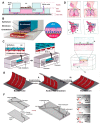Air Quality Effects on Human Health and Approaches for Its Assessment through Microfluidic Chips
- PMID: 28953246
- PMCID: PMC5664094
- DOI: 10.3390/genes8100244
Air Quality Effects on Human Health and Approaches for Its Assessment through Microfluidic Chips
Abstract
Air quality depends on the various gases and particles present in it. Both natural phenomena and human activities affect the cleanliness of air. In the last decade, many countries experienced an unprecedented industrial growth, resulting in changing air quality values, and correspondingly, affecting our life quality. Air quality can be accessed by employing microchips that qualitatively and quantitatively determine the present gases and dust particles. The so-called particular matter 2.5 (PM2.5) values are of high importance, as such small particles can penetrate the human lung barrier and enter the blood system. There are cancer cases related to many air pollutants, and especially to PM2.5, contributing to exploding costs within the healthcare system. We focus on various current and potential future air pollutants, and propose solutions on how to protect our health against such dangerous substances. Recent developments in the Organ-on-Chip (OoC) technology can be used to study air pollution as well. OoC allows determination of pollutant toxicity and speeds up the development of novel pharmaceutical drugs.
Keywords: PM2.5; air pollution; microchip; organ-on-chip (OoC); particulate matter (PM).
Conflict of interest statement
The authors declare no conflict of interest.
Figures




Similar articles
-
Mortality and Morbidity Effects of Long-Term Exposure to Low-Level PM2.5, BC, NO2, and O3: An Analysis of European Cohorts in the ELAPSE Project.Res Rep Health Eff Inst. 2021 Sep;2021(208):1-127. Res Rep Health Eff Inst. 2021. PMID: 36106702 Free PMC article.
-
The Minderoo-Monaco Commission on Plastics and Human Health.Ann Glob Health. 2023 Mar 21;89(1):23. doi: 10.5334/aogh.4056. eCollection 2023. Ann Glob Health. 2023. PMID: 36969097 Free PMC article. Review.
-
National Particle Component Toxicity (NPACT) Initiative: integrated epidemiologic and toxicologic studies of the health effects of particulate matter components.Res Rep Health Eff Inst. 2013 Oct;(177):5-13. Res Rep Health Eff Inst. 2013. PMID: 24377209
-
Characterizing Determinants of Near-Road Ambient Air Quality for an Urban Intersection and a Freeway Site.Res Rep Health Eff Inst. 2022 Sep;2022(207):1-73. Res Rep Health Eff Inst. 2022. PMID: 36314577 Free PMC article.
-
Advances of microfluidic lung chips for assessing atmospheric pollutants exposure.Environ Int. 2023 Feb;172:107801. doi: 10.1016/j.envint.2023.107801. Epub 2023 Feb 4. Environ Int. 2023. PMID: 36774736 Review.
Cited by
-
PM2.5 exposure and lung function impairment among fiber-cement industry workers.J Public Health Res. 2023 Jan 13;12(1):22799036221148989. doi: 10.1177/22799036221148989. eCollection 2023 Jan. J Public Health Res. 2023. PMID: 36654813 Free PMC article.
-
The Impact of PM2.5 on the Host Defense of Respiratory System.Front Cell Dev Biol. 2020 Mar 4;8:91. doi: 10.3389/fcell.2020.00091. eCollection 2020. Front Cell Dev Biol. 2020. PMID: 32195248 Free PMC article. Review.
-
Airborne Particulates Affect Corneal Homeostasis and Immunity.Invest Ophthalmol Vis Sci. 2020 Apr 9;61(4):23. doi: 10.1167/iovs.61.4.23. Invest Ophthalmol Vis Sci. 2020. PMID: 32301974 Free PMC article.
-
In Vitro and In Vivo Experimental Studies of PM2.5 on Disease Progression.Int J Environ Res Public Health. 2018 Jul 1;15(7):1380. doi: 10.3390/ijerph15071380. Int J Environ Res Public Health. 2018. PMID: 29966381 Free PMC article. Review.
-
The Influence of Traffic-Related Air Pollution (TRAP) in Primary Schools and Residential Proximity to Traffic Sources on Histone H3 Level in Selected Malaysian Children.Int J Environ Res Public Health. 2021 Jul 28;18(15):7995. doi: 10.3390/ijerph18157995. Int J Environ Res Public Health. 2021. PMID: 34360284 Free PMC article.
References
-
- Hajati A., Latev D., Gardner D., Hajati A., Imai D., Torrey M., Schoeppler M. Three-dimensional micro electromechanical system piezoelectric ultrasound transducer. Appl. Phys. Lett. 2012;101:253101. doi: 10.1063/1.4772469. - DOI
-
- Hajati A., Latev D., Gardner D., Ottosson M., Imai D., Torrey M., Schoeppler M. Monolithic ultrasonic integrated circuits based on micromachined semi-ellipsoidal piezoelectric domes. Appl Phys. Lett. 2013;103:202906. doi: 10.1063/1.4831988. - DOI
Publication types
LinkOut - more resources
Full Text Sources
Other Literature Sources

